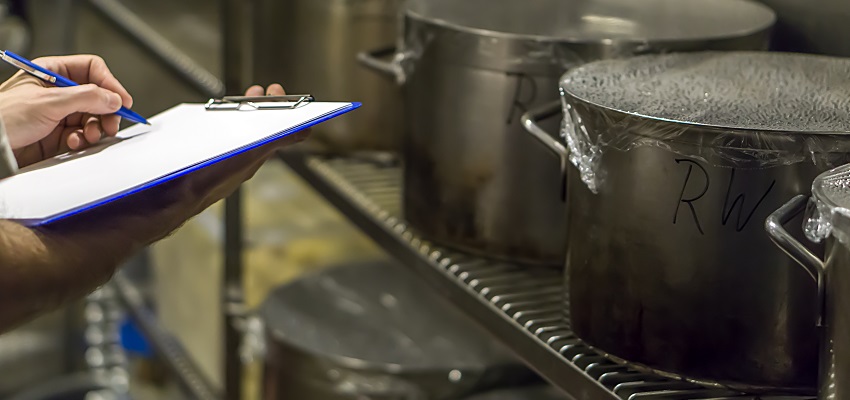Here’s what health inspectors look for in your restaurant, and why

Maintain a written or electronic record of when temperatures were taken and by whom; that’s what the inspector will want to see.
Your operation’s relationship with the city health department will be a positive one when you understand what inspectors look for when they visit, and more importantly, why they draw attention to the things they do. Let them help you to ensure you and your team are following the food handling practices that make your food not just delicious but always safe for customers.
Areas of interest for inspectors include:
Food storage
One of the most common practices inspectors will look for is proper food storage because cross-contamination, one of the leading causes of foodborne illness, can occur when pathogens on raw foods transfer through contact to ready-to-eat foods.
Separate all raw and ready-to-eat food items into their own designated areas of cold storage OR store them vertically on walk-in shelves in the following top-to-bottom order:
- Ready-to-eat food
- Seafood
- Whole cuts of beef and pork
- Ground meat and ground fish
- Whole and ground poultry
Additionally, label foods accurately and with clear use-by dates, store foods in designated food-grade storage containers, and perform nightly cold-storge inspections to ensure items are covered and stored properly.
Time and temperature
Certain foods become unsafe when they fall between the temperatures of 41°F and 135°F (known as the temperature danger zone) for an extended period. The longer food sits in this range, the higher the risk it has of harboring and multiplying harmful bacteria.
To keep foods safe, hold hot foods at or above 135°F, keep cold foods at or below 41°F, record food temperatures regularly, and carefully limit the amount of time food spends in the temperature danger zone. Maintain a written or electronic record of when temperatures were taken and by whom; that’s what the inspector will want to see.
Cross-contamination
Foods can be contaminated when pathogens get transferred from one food or surface to another. Apart from improper storage when certain foods touch or drip on others, cross-contamination can also occur when food is mishandled during preparation or serving.
To avoid cross-contamination:
- Make sure all food handlers are trained and certified in food safety and allergen awareness.
- Ensure all staff members follow good personal hygiene protocols.
- Provide your kitchen staff with color-coded utensils and cutting boards.
- Store chemicals in a designated area away from food.
- Wash all fruits and vegetables before preparing and serving.
Personal hygiene
Your team’s good personal hygiene is critical for reducing the spread of pathogens and maintaining a safe restaurant, and inspectors will take notice. If employees don’t follow handwashing guidelines, wear dirty clothes, or show up to work sick, your operation could be at risk.
Employees should wash their hands after:
- Using the restroom
- Leaving and returning to kitchen/prep areas
- Touching their face, hair, or clothing
- Eating, drinking, smoking, or chewing gum
- Clearing tables, busing dirty dishes, or taking out the trash
- Handling raw meat, poultry, or seafood
- Handling chemicals
Back-of-house staff should wear clean clothes every day, aprons and gloves when necessary, and hair coverings. They should also remove jewelry like rings or watches when they’re working in food-prep areas.
If team members display signs of illness, send them home until they’ve fully recovered.
Cleaning and sanitization
Cleaning removes food and other dirt from surfaces. Sanitizing reduces bacteria on a surface to safe levels. Surfaces and equipment that aren’t properly sanitized after coming into contact with food can grow dangerous bacteria. Sanitizing requires a careful mixture of chemicals to kill bacteria on the spot (see below).
With an approved sanitizing solution, wipe down all surfaces that come into contact with food, including kitchen counters and prep stations, cutting boards, pans, and knives. Make sure all food prep surfaces are smooth and cleaned frequently. Throw away damaged or worn cutting boards or utensils. When sanitizing surfaces, utensils, or equipment, follow this process:
- Scrape or rinse away food.
- Wash using an approved cleaning product.
- Rinse using clean water.
- Sanitize using an approved solution.
- Allow surfaces, utensils, or equipment to air dry.
- Wash sanitizing agents completely after sanitizing solutions have set on the surface for the proper amount of time (per manufacturer instructions) or use a safe no-rinse solution.
Using the right sanitizers
Part of staying compliant is using Food and Drug Administration-approved chemical sanitizers. The most common sanitizers for foodservice are chlorine, iodine, and quaternary ammonium (quats). These are some common factors impacting sanitizer effectiveness:
- Concentration: A concentration that is too low won’t effectively sanitize, while too high of a concentration can be toxic. Always mix sanitizers with the appropriate amount of water as listed on the instructions.
- Water temperature: Sanitizers are most effective in water that is between 55°F and 120°F.
- Contact time: To effectively reduce bacteria to safe levels, sanitizers should remain in contact with food-contact surfaces for 10–30 seconds.
- pH: Sanitizers work better in more neutral environments.
When using sanitizers, follow the product instructions carefully to ensure safety and effectiveness. Learn more about approved sanitizers here.
Staying inspection-ready
Treat every day as a possible inspection day by downloading our Self-Inspection Checklist to ensure you’re covering all your food safety bases.
Another essential component of staying inspection-ready is making sure employees are food-handler trained and up to date on food safety best practices. ServSafe is the No. 1 choice across the country for comprehensive food safety training and certification, empowering restaurant employees to work safer.
Cracking the code on food safety
Check out foodsafetyfocus.com for the entire library of National Food Safety Month 2023 content including blogs, checklists, eBooks, posters, and other NFSM 2023 printable content you won’t want to miss. Check out discounts on ServSafe training products this month, too.